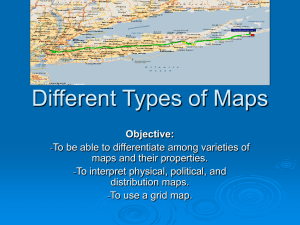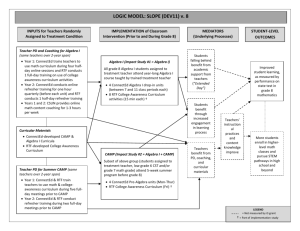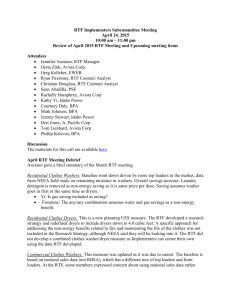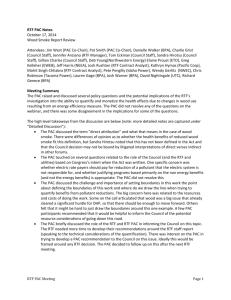Sense Units - PHSch. Caesar
advertisement
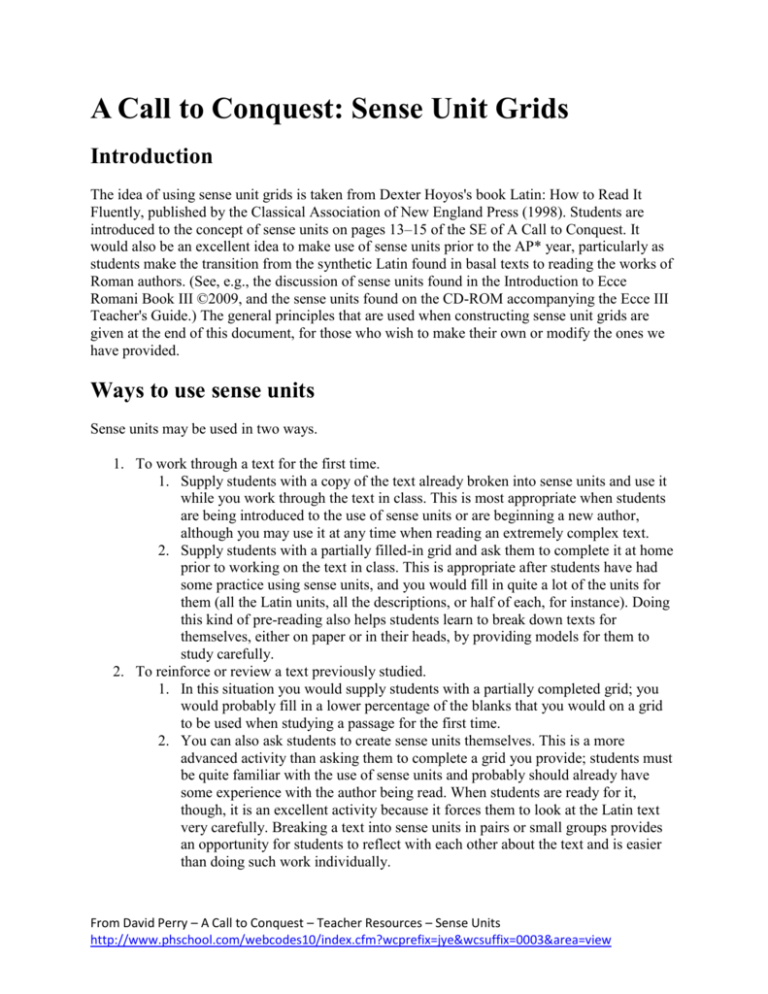
A Call to Conquest: Sense Unit Grids Introduction The idea of using sense unit grids is taken from Dexter Hoyos's book Latin: How to Read It Fluently, published by the Classical Association of New England Press (1998). Students are introduced to the concept of sense units on pages 13–15 of the SE of A Call to Conquest. It would also be an excellent idea to make use of sense units prior to the AP* year, particularly as students make the transition from the synthetic Latin found in basal texts to reading the works of Roman authors. (See, e.g., the discussion of sense units found in the Introduction to Ecce Romani Book III ©2009, and the sense units found on the CD-ROM accompanying the Ecce III Teacher's Guide.) The general principles that are used when constructing sense unit grids are given at the end of this document, for those who wish to make their own or modify the ones we have provided. Ways to use sense units Sense units may be used in two ways. 1. To work through a text for the first time. 1. Supply students with a copy of the text already broken into sense units and use it while you work through the text in class. This is most appropriate when students are being introduced to the use of sense units or are beginning a new author, although you may use it at any time when reading an extremely complex text. 2. Supply students with a partially filled-in grid and ask them to complete it at home prior to working on the text in class. This is appropriate after students have had some practice using sense units, and you would fill in quite a lot of the units for them (all the Latin units, all the descriptions, or half of each, for instance). Doing this kind of pre-reading also helps students learn to break down texts for themselves, either on paper or in their heads, by providing models for them to study carefully. 2. To reinforce or review a text previously studied. 1. In this situation you would supply students with a partially completed grid; you would probably fill in a lower percentage of the blanks that you would on a grid to be used when studying a passage for the first time. 2. You can also ask students to create sense units themselves. This is a more advanced activity than asking them to complete a grid you provide; students must be quite familiar with the use of sense units and probably should already have some experience with the author being read. When students are ready for it, though, it is an excellent activity because it forces them to look at the Latin text very carefully. Breaking a text into sense units in pairs or small groups provides an opportunity for students to reflect with each other about the text and is easier than doing such work individually. From David Perry – A Call to Conquest – Teacher Resources – Sense Units http://www.phschool.com/webcodes10/index.cfm?wcprefix=jye&wcsuffix=0003&area=view You may ask students to number the units using a narrow column at the left. See the files with I.2 and I.7 arranged in sense units for examples. Use letters (1a, 1b, etc.) to indicate clauses that are interrupted by nested elements. Grids provided The PDF files linked below contain sense unit grids for the following chapters of Caesar's De bello Gallicō. Answer keys are given after each blank grid. 1.2: intended as a review/do now activity after students have worked through the text the day before, for students who are already familiar with using sense units. You could make this easier by filling in more elements. Answer key on the second page. 1.7: this file provides the long, complex sentence broken into sense units for reading the text initially. There is also a review grid with all the English elements and numbers are filled in, so it is easier. 4.24: This is formatted as a grid, with numbers. 4.27: This long, complex sentence is given as units and then as a grid. 4.30: Here is a grid with all English identifications and numbers filled in. 5.27: This long chapter in indirect speech is broken down into sense units to make things easier for students, and the indirect statements dependent on locūtus est are marked in small capitals. 5.43: Another one in units for initial exploration and also as a review grid. There are several grids for sentences in Book IV because this portion of the AP readings contains several complex sentences, while Book I has only one really complicated sentence (§7). The files Two versions of the sense unit files are provided. Grids from the PDF files may be printed and distributed to students, and the answer keys projected to let students check their work. If you wish to modify the grids provided, you can use the RTF files. RTF (rich text format) is a format that can be opened by many different word processing programs. All grids are formatted as tables. If you do not know how to add or delete rows in a table, see your program's help system. PDF Files 1.2 sense units (PDF, 30 KB) 1.7 sense units (PDF, 44 KB) 4.24 sense units (PDF, 54 KB) 4.27 sense units (PDF, 49 KB) From David Perry – A Call to Conquest – Teacher Resources – Sense Units http://www.phschool.com/webcodes10/index.cfm?wcprefix=jye&wcsuffix=0003&area=view 4.30 sense units (PDF, 41 KB) 5.27 sense units (PDF, 27 KB) 5.43 sense units (PDF, 26 KB) RTF Files 1.2 sense units (RTF, 101 KB) 1.7 sense units (RTF, 180 KB) 4.24 sense units (RTF, 160 KB) 4.27 sense units (RTF, 168 KB) 4.30 sense units (RTF, 169 KB) 5.27 sense units (RTF, 53 KB) 5.43 sense units (RTF, 78 KB) Making your own If you wish to make additional sense unit grids of your own, you can modify any of the RTF files provided; just delete the text given and replace it with your own, saving under a different name. Principles for constructing sense units a main clause is always at the left margin the main clauses of compound sentences are printed on separate lines (unless they are extremely short) the following subordinate units are indented and printed on separate lines: o subordinate clauses o participial phrases (participles with no objects or modifiers are kept with the clause in which they are found) o ablative absolutes indirect statement is kept in the same clause as the head verb (since it functions as the direct object of that verb) within a sentence, each unit is printed with a small amount of space above and below, which makes it easier to mark up the texts (e.g., to show agreement of nouns and adjectives) a unit that that ought to appear on a single line, but is too long to fit, is printed single spaced each sentence is separated by a blank line Clauses, participial phrases, and ablative absolutes were selected for printing on separate lines because we want to teach students to think in terms of structure as they work with the complicated sentences of Latin literature. We have made a few exceptions to these rules when needed for clarity; for instance, a unit such as indirect statement that would normally not be on its own line might be separated because it, or the sentence around it, was unusually lengthy or complicated. From David Perry – A Call to Conquest – Teacher Resources – Sense Units http://www.phschool.com/webcodes10/index.cfm?wcprefix=jye&wcsuffix=0003&area=view


